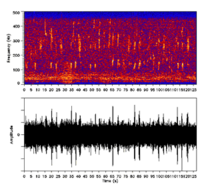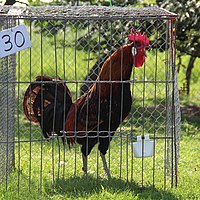Bioacoustics
[1] This involves neurophysiological and anatomical basis of sound production and detection, and relation of acoustic signals to the medium they disperse through.
Bioacoustics as a scientific discipline was established by the Slovene biologist Ivan Regen who began systematically to study insect sounds.
[5] Regen's most important contribution to the field apart from realization that insects also detect airborne sounds was the discovery of tympanal organ's function.
More accurate measurements were made possible in the second half of the 20th century by advances in electronics and utilization of devices such as oscilloscopes and digital recorders.
Gauging the relative importance of audition versus vision in animals can be performed by comparing the number of auditory and optic nerves.
Bioacoustics has also helped to pave the way for new emerging methods such as ecoacoustics (or acoustic ecology),[9] an interdisciplinary field of research that studies the sounds produced by ecosystems, including biological, geophysical and anthropogenic sources.
By analysing soundscapes, ecoacoustics helps monitor environmental changes, assess conservation efforts and detect human impacts on natural systems.
Animal sound collections, managed by museums of natural history and other institutions, are an important tool for systematic investigation of signals.
While there are many manufacturers of commercially available "fish-finders," quantitative analysis requires that measurements be made with calibrated echo sounder equipment, having high signal-to-noise ratios.
A segmented marine worm Leocratides kimuraorum produces one of the loudest popping sounds in the ocean at 157 dB, frequencies 1–100 kHz, similar to the snapping shrimps.
In a series of scientific journal articles published between 2013 and 2016, Monica Gagliano of the University of Western Australia extended the science to include plant bioacoustics.




